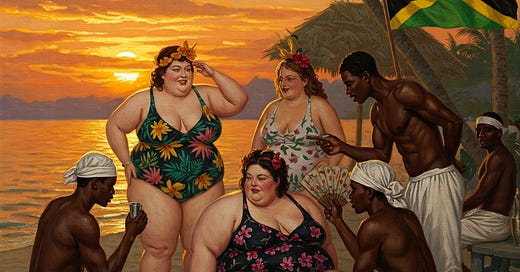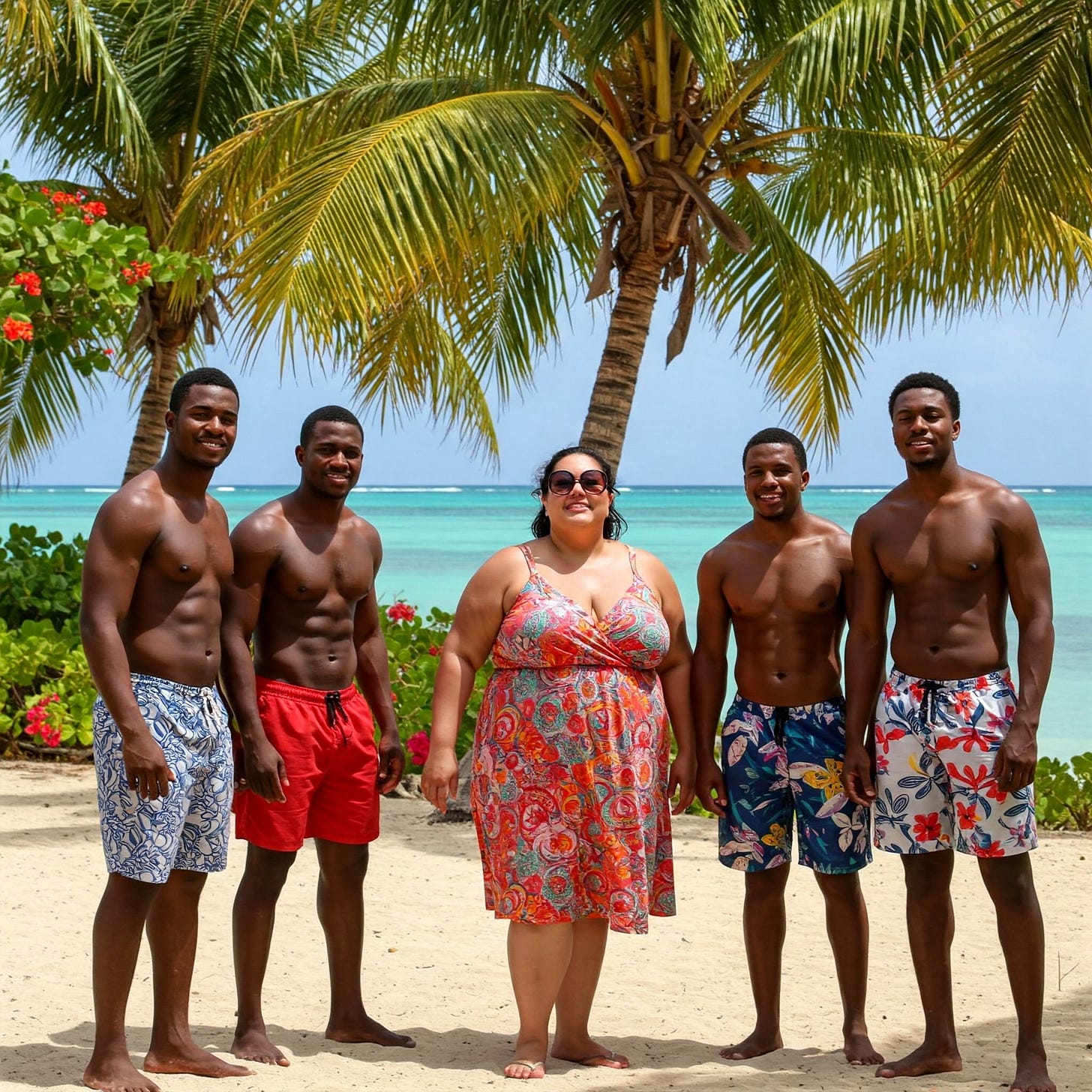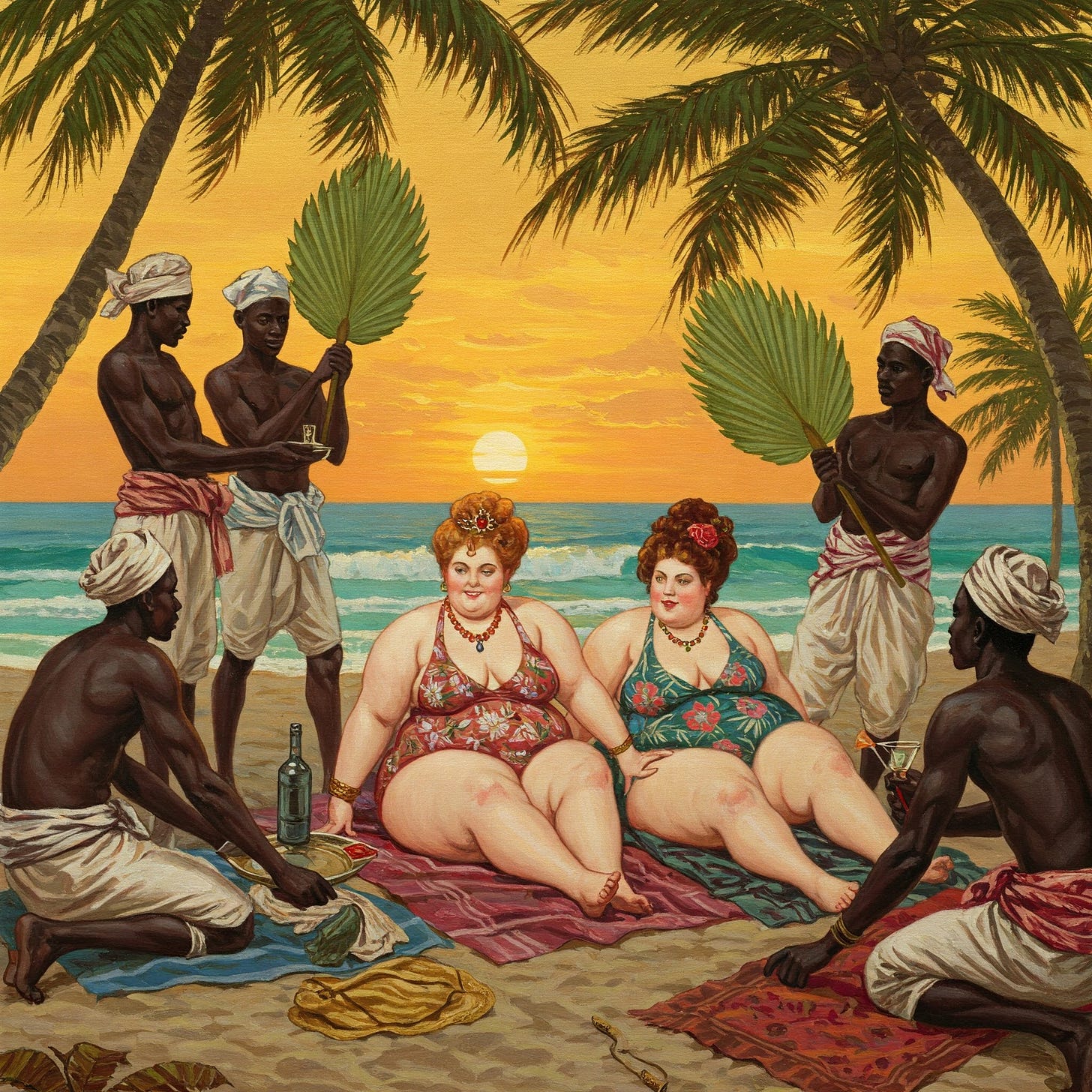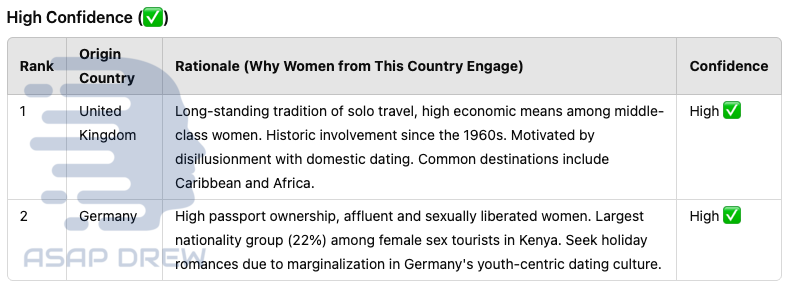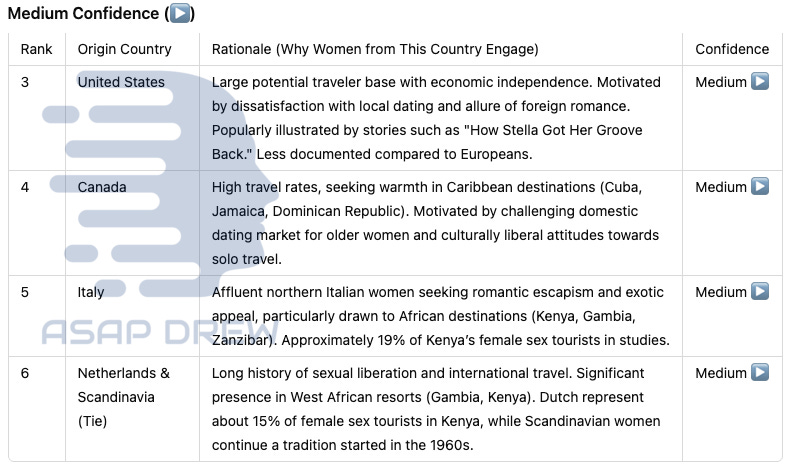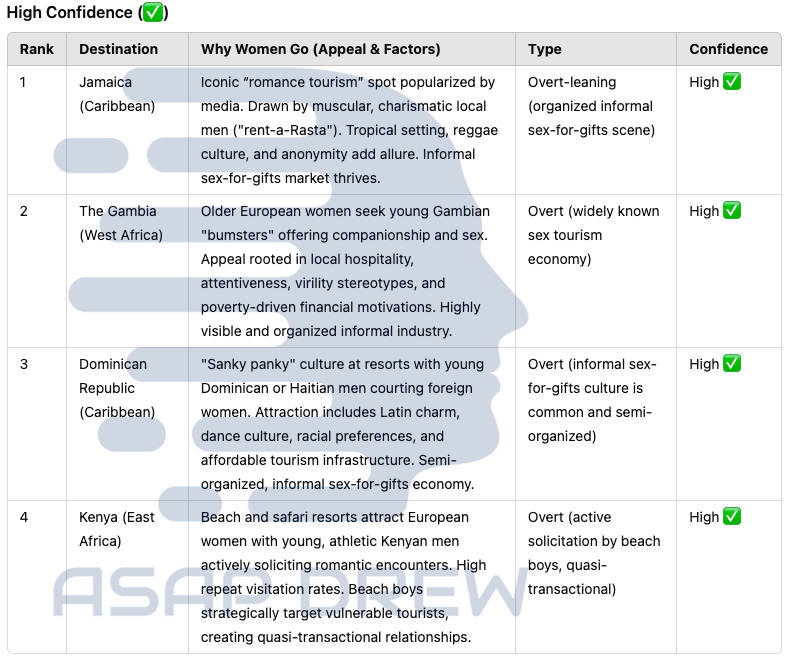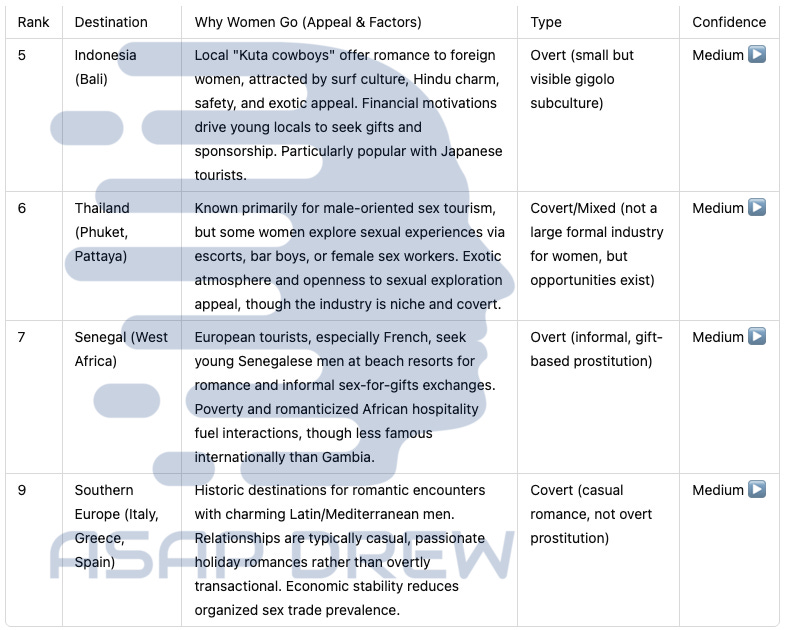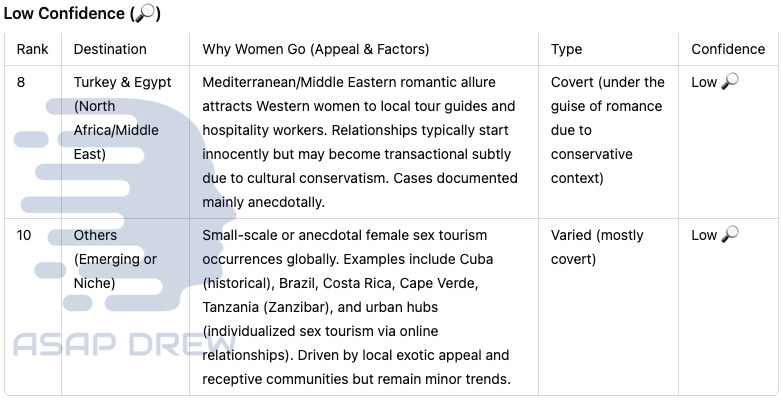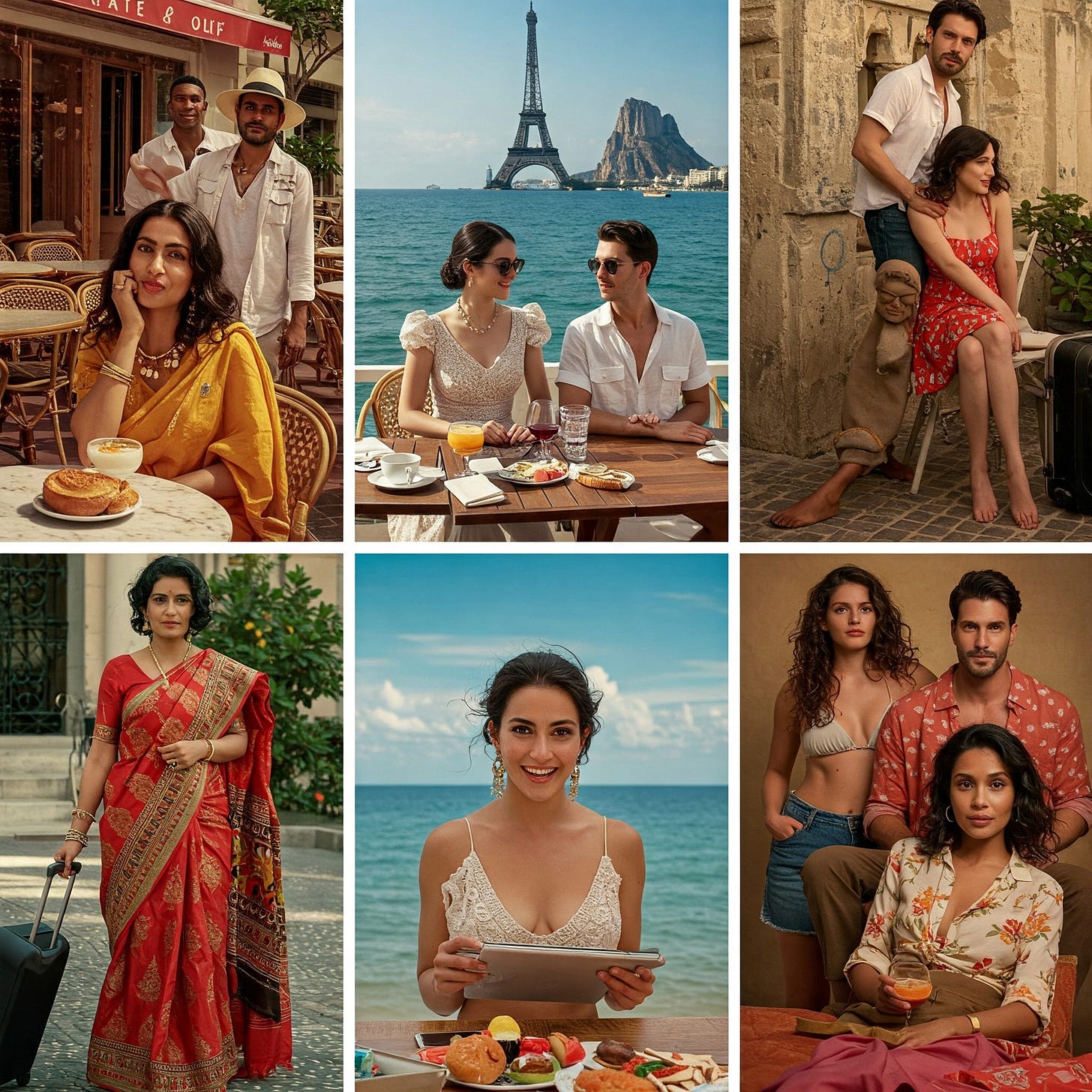Female Sex Tourism & Foreign Romance Vacations: Global Trends, Demographics, Top Destinations (2025 Analysis)
Are some women traveling to other countries for sex tourism & foreign romance? Is the sky blue?
It’s common knowledge that many men are traveling overseas for sex tourism in 2025. Known destinations for men include:
Latin America (Brazil & Colombia)
Southeast Asia (Philippines, Thailand, Indonesia, Vietnam, Cambodia, Malaysia)
Eastern Europe (Romania, Bulgaria, Serbia, Russia, Croatia)
But what about women? The reality is that most women aren’t as motivated by pure “sex” as men for various reasons (sex-specific brain/hormone wiring AND the fact that they can get “sex” or quick hookups easier than most men anywhere — just login to a dating app).
The sex-specific brain/hormone wiring and disparities are best summed up in the following clip from Tom Segura:
Something I suspect is true, and have always said, is that: sexual lust for men is akin to romantic lust for women. (I could be off base but it’s one of my theories).
A significant percentage of women are motivated by “romance” and “romantic” excursions which often involve sex. They want to feel “true love,” get wined & dined, and then sex… sometimes they don’t even want sex though.
This is why there is a booming industry for “host clubs” in places like Tokyo and Osaka wherein women pay attractive male hosts to entertain them with conversation, drinking, emotional intimacy, and flattery. (Allegedly the leading “gigolo” was making ~$200k/night for a while. You can YouTube “host clubs” Japan & Tokyo on YouTube to learn more.)
If I had to speculate on types of women/females that engage in both overt/covert sex tourism… here’s how I’d guess (this is just me throwing darts):
Older age, affluent, obese, divorcee (?), never married: Africa or Caribbean
Nerdy, younger, overweight/obese, anime/K-pop fans: Japan & South Korea
Younger, adventurous, explorer: EU (Italy, France, Spain), UK (England, Ireland, etc.) or Latin America
LGBTQ+: Southeast Asia (Thailand, Indonesia, Philippines)
I’d guess most female sex tourists care a lot about: safety, not getting HIV/AIDS, guys that are taller than them, and some fantasized version of reality (based on what they’ve read or heard or whatever).
LGBTQ+ are probably a bit more risk-oriented and don’t care as much about height — the dynamic is different vs. straight women (most want height/taller than them… this is #1 behind things like safety, things to do, scenery, level of country development, etc.).
The older affluent obese women engaged in overt sex tourism usually go to specific establishments with STD-tested African-ethnicity men. Why African men? The women are often obese, African men tend to appreciate “curves,” larger women tend to have larger/obesity-stretched canals… and African men may be able to fill the void.
I’d guess that most of these women dislike dating in their own countries, have shaky confidence, and keep going to the same places for consistency (why take risks when they’ve found a place they like?)… they are doted on 24/7 and like the attention. There are some older documentaries on this stuff.
The younger female crowd is basically: non-nerds go to EU/UK and nerds go to Asia (Japan & Korea). Occasionally some non-nerds who want to explore and learn Spanish go to Latin America.
These are more “covert” cases of sex tourism… sex/romance is part of the goal — but not the only goal (though it ranks higher than most will admit). I’d guess that for older women, the romance aspect is more appealing than the sex.
Younger women want romance too, but they are “young” and “exploring” so the exploration/novelty aspect is most appealing (partying, clubbing, festivals, etc.) with guys from wealthy countries (high standard of living), tall average heights, and exotic foreign “looks” and accents.
For this reason, it makes logical sense that younger American women take “semesters abroad” more frequently than American men (~67% female vs. ~33% male). Some of this is due to base college student demographics by sex. (Statista: Sex of Students Abroad)
But even after controlling for college student composition by sex (~58% female vs. ~42% male) — women are about 1.5x more likely to study abroad than men.
Top destinations for study abroad programs for U.S. students in 2025? Data from the IIE indicates that women favor destinations in Europe (Italy, Spain, UK) while men favor locations in Asia (China & Japan). (OpenDoors Data)
Not going to go too deep in the weeds here re: demographics of “semester abroad” because this piece is on overt/covert female sex tourism (perhaps most females would prefer it publicly framed as “romance tourism”). Just highlighting that the data “add up.”
Note: An extrapolation of this trend is basically the show on TLC show “90 Day Fiance” wherein many women attempt to “lock down” their foreign guys… usually ends abysmally (similar to the guys — just a different dynamic).
I. Female Sex Tourism & Foreign Romance Vacations
Female sex tourism refers to women traveling with the intent (overt or covert) to engage in sexual or romantic liaisons with local partners. Although far less common than male sex tourism, it occurs globally – from Caribbean beaches to African resorts and even via social networking apps.
Overt female sex tourism involves explicit pursuit of sexual encounters (sometimes transactional) as a primary motive, for example, women taking solo or group trips to destinations known for accommodating local “beach boys” or gigolos.
Covert forms blur into ordinary travel – a woman might use hospitality exchanges (e.g. Couchsurfing) or dating apps to secure companionship or free lodging with an unspoken understanding of a sexual quid pro quo.
This report examines the archetypes of women who engage in these practices, the top origin and destination countries (with rationales and confidence levels), key motivations (ranked by influence), historical vs. modern trends (through the 2020s), and the frequency/habits associated with female sex tourism.
Both confirmed data and logical inferences are included, with comparisons to male sex tourism for context.
II. Psychological Archetypes & Demographics of Female Sex Tourists (2025)
A middle-aged Western woman sits at a beachside bar in Kenya. Many female sex tourists are older women from developed countries, often traveling alone. They seek attention and intimacy abroad that they feel is unavailable at home.
Demographics
Female sex tourists are most often middle-aged or older women (typically 40–60 years old), usually white and from affluent Western nations. They often travel solo or with other female friends.
A common profile is a woman who has had unsatisfying or unhappy relationships in her past and now feels neglected or undesirable in her local dating market.
Emotionally, they may be lonely, seeking romance or validation, and open to adventure. Many are divorced or never married; some are widowed or have grown children, giving them both the freedom and desire to explore new relationships.
These women frequently report feeling overlooked by men at home due to factors like age or body shape, and abroad they suddenly find themselves pursued and appreciated.
In a Kenyan study, over 60% of female sex tourists were ages 46–50, and many cited that being “older and overweight” made them feel rejected by Western men – a dynamic that “is suddenly reversed” in destinations where local men shower them with attention.
Perhaps a combo of: New Weight Loss Drugs & Gene Editing for Obesity will eventually quash this specific segment of the industry: obese women → Africa vacations?
Indeed, being romantically and sexually desired by younger, attractive locals provides a major self-esteem boost for these women.
Despite the stereotype of the older heterosexual “cougar” sex tourist, not all female sex tourists are straight or of the same age profile. The vast majority do appear to be heterosexual women interested in local men, but there are notable LGBTQ+ patterns as well.
Some women travelers (often younger) pursue same-sex encounters or seek out female sex workers while abroad.
For example, research in Australia found women may be more likely to pay female escorts than male escorts when they did buy sex, suggesting a subset of lesbian or bisexual female tourists who engage in sexual tourism with women. (The SAGE Handbook of Global Sexualities)
Generally, however, female sex tourism by queer women is less documented and tends to occur in informal ways (e.g. lesbian tourists visiting queer-friendly locales and hooking up with local women through dating apps or nightlife, rather than an established “tourism circuit”).
Meanwhile, the body composition of female sex tourists varies, but observers often note a higher proportion of women who are overweight or of average looks – individuals who might struggle to find confident partners at home due to Western beauty standards.
These women find that in destinations like Africa or the Caribbean, local men pay court to them enthusiastically, admiring traits (like a fuller figure or mature age) that Western men might eschew.
Overall: The typical female sex tourist is an older, financially independent woman – often white, 40s or 50s, single/divorced, possibly not conventionally attractive by her home culture’s standards – who is seeking romance, sexual fulfillment, or simply the feeling of being desired. Heterosexual women dominate this space, typically pursuing younger local men, while a smaller segment of women (often LGBTQ+) may travel for encounters with women.
Emotional & Psychological Traits
These women often exhibit a mix of adventurousness and vulnerability. On one hand, they are adventurous enough to travel independently and defy traditional norms for older women’s sexuality (in many societies, older women are expected to be sexually passive or asexual).
They embrace the thrill of a no-strings-attached romance abroad. On the other hand, many carry emotional wounds – feelings of inadequacy or “invisibility” with men at home – which make them susceptible to the intense flattery and attention offered by tourist-area gigolos.
Psychologically, they may rationalize their behavior as “finding love” or a genuine connection rather than paying for sex, highlighting a need for intimacy and validation. Indeed, researchers note that female sex tourists often genuinely believe (at least initially) that the beach boy suitor loves them – hence terms like “romance tourism” to capture the emotional framing.
There is often a fantasy element: the idea of an exotic lover who makes them feel special, in a tropical paradise away from everyday life. This speaks to escapism and the desire to reclaim youth or sexuality. Many are at a life stage (empty nest, post-divorce, mid-life crisis) where they seek new experiences to “feel alive” again.
Overall: The archetype is a woman who is yearning for affection, excitement, and sexual satisfaction that she perceives as unattainable in her routine life – and who has the means and boldness to seek it abroad.
III. Top Origin Countries of Female Sex Tourists & Romance Tourists (2025)
Women who engage in sex tourism predominantly come from wealthy, industrialized countries, where women have the resources and social freedom to travel solo.
Below is a ranking of the most common origin countries for female sex tourists, along with the rationale and confidence level for each.
1. United Kingdom (UK)
Long-standing tradition of international travel, particularly among middle-class, single, or divorced women.
Historical engagement in romance tourism dating back to the 1960s (initially in the Mediterranean, now Africa/Caribbean).
Frustration with local dating culture; older British women often travel to The Gambia, Kenya, and Jamaica.
Confidence: High ✅
2. Germany
High passport ownership, extensive travel culture, and liberal attitudes toward sexuality among German women.
Significant financial independence and willingness to seek romantic and sexual experiences abroad.
Prominent presence in Kenyan coastal areas and other African/Caribbean destinations due to dissatisfaction with Germany’s youth-centric dating environment.
Confidence: High ✅
3. United States (U.S.)
Large population of economically independent women (Baby Boomers, Gen-X) able and willing to travel internationally.
Popularized by cultural phenomena (e.g., How Stella Got Her Groove Back); American women frequent Caribbean destinations like Jamaica.
Motivated by dissatisfaction with the local dating scene and the allure of exotic romantic encounters, though less documented due to the accessibility of domestic dating options.
Confidence: Medium ▶️
4. Canada
Similar culturally to the UK/US; Canadian women regularly travel abroad, particularly escaping cold winters to warmer Caribbean destinations (Cuba, Jamaica, Dominican Republic).
Challenges in local dating market (smaller population, age preferences of divorced men) motivate overseas romance-seeking.
Liberal attitudes toward solo travel and sexuality facilitate engagement in foreign romantic relationships.
Confidence: Medium ▶️
5. Italy
Affluent Northern Italian women face traditional dating culture constraints domestically (limited options for older women).
Historical and ongoing travel to Kenya’s coast (Malindi, Mombasa), Gambia, and Zanzibar, drawn by the romantic allure and perceived virility of African men.
Notably represented among European sex tourists despite smaller global share compared to English-speaking countries.
Confidence: Medium ▶️
6. Netherlands & Scandinavia (Tie)
History of sexual liberation, gender equality, and high rates of international travel among Dutch and Scandinavian women.
Among the earliest to seek romantic experiences abroad (Southern Europe in the 1960s).
Frequent presence in West African resorts (Dutch in The Gambia, Scandinavians in The Gambia and Kenya).
High per-capita participation despite smaller absolute population numbers.
Confidence: Medium ▶️
7. Australia & Japan (Honorable Mention)
Australian women engage in casual sex or hiring local companions, predominantly in Southeast Asian locations (Bali, Thailand). Cultural independence and financial capacity facilitate this travel.
Japanese "office ladies" notably travel to Bali and Thailand, seeking romantic freedom and escape from conservative domestic dating norms.
Emerging trends rather than large-scale participation, hence relatively lower incidence compared to North America or Europe.
Confidence: Low 🔎
Analysis:
Women from the above countries share certain enabling factors. Affluence and access to travel are fundamental – they hail from economies where middle-class women can afford international vacations.
These societies also tend to be relatively culturally permissive regarding women traveling alone and expressing sexuality (e.g. Northern Europe, Anglophone countries). Moreover, many of these countries have dating cultures or demographics that leave some women (especially older or plus-sized women) feeling “dissatisfied with local options.”
For instance, in the UK, US, and Canada, women often report a dearth of available, age-appropriate men who are interested in committed relationships; in Germany and Scandinavia, there is strong cultural egalitarianism, but men there may not provide the kind of chivalrous attention some women desire.
Thus, women from these places might seek the perceived romance, machismo, or attentiveness of foreign men. The legacy of colonial and language ties also plays a role – British women find it easy to travel in English-speaking former colonies (Caribbean, Africa), Italian women had connections in East Africa, French women in West Africa, etc.
This familiarity lowers barriers to these encounters. It’s worth noting that not all female travelers from these countries engage in sex tourism, of course. This is a niche subgroup. But when female sex tourism does occur, it disproportionately involves women from Western Europe (UK, Germany, Netherlands, Nordics, Italy) and North America (USA, Canada), with Australia and parts of East Asia (Japan) contributing smaller numbers.
Women from developing or more restrictive countries seldom appear in this context – for example, it’s rare to hear of, say, a Saudi or Indian woman traveling to find sexual partners, due to cultural and economic constraints. In contrast, Western women enjoy both the means and relative social freedom to explore such activities abroad.
IV. Top Destination Countries for Female Sex Tourism (2025)
Female sex tourists tend to gravitate to sunny, exotic destinations where local men are not only physically appealing to them but also receptive (often for economic reasons) to relations with foreign women.
These destinations can be divided into overt sex tourism hotspots – places notorious for a local sex trade catering to women – and covert or informal locales, where liaisons occur via social interactions (parties, social media) rather than an obvious sex industry.
Below is a ranked list of destinations where women most often travel for sexual/romantic encounters, with reasoning and an indication of whether the scene is overt or more covert.
1. Jamaica (Caribbean)
Appeal & Factors: Iconic romance tourism; muscular, charismatic local men ("rent-a-Rasta") offering flattery, passion, and companionship in exchange for indirect financial support. Exotic setting, reggae culture, anonymity, and active informal market in Negril and Montego Bay.
Type: Overt-leaning (organized informal sex-for-gifts scene)
Confidence: High ✅
2. The Gambia (West Africa)
Appeal & Factors: Famous for older European women seeking younger Gambian men ("bumsters"). Attraction based on stereotypes of African virility and extreme local poverty driving men’s willingness to pursue foreign women for financial stability. Highly visible interactions around beach resorts.
Type: Overt (widely known sex tourism economy)
Confidence: High ✅
3. Dominican Republic (Caribbean)
Appeal & Factors: Known for "sanky panky" (local gigolos) who charm foreign women at resorts in Puerto Plata, Sosúa, Punta Cana. Appeal involves Latin charm, Afro-Latino appearance, and romantic encounters in an all-inclusive, relaxed atmosphere. Transactions often subtle, involving gifts and financial "help."
Type: Overt (informal sex-for-gifts culture, semi-organized)
Confidence: High ✅
4. Kenya (East Africa)
Appeal & Factors: Popular among European women seeking romance and adventure with local "beach boys" or safari guides in coastal towns (Mombasa, Malindi). Men target vulnerable tourists (older/heavier) to secure financial benefits. Repeat visits common due to fantasy fulfillment and affectionate treatment.
Type: Overt (active solicitation, quasi-transactional)
Confidence: High ✅
5. Indonesia (Bali)
Appeal & Factors: Local "Kuta cowboys" court female tourists drawn by Balinese charm, surf culture, and spiritual atmosphere. Japanese, Australian, and European women frequent Bali for relationships combining genuine attraction with financial support. Smaller, visible gigolo subculture compared to Caribbean/African locations.
Type: Overt (small but visible gigolo subculture)
Confidence: Medium ▶️
6. Thailand (Phuket, Pattaya)
Appeal & Factors: Primarily famous for male tourists but female tourists also explore bisexual or heterosexual experiences. Encounters may involve local escorts or casual flings arranged through dating apps. Exotic mystique and open sexual environment.
Type: Covert/Mixed (limited formal industry for women)
Confidence: Medium ▶️
7. Senegal (West Africa)
Appeal & Factors: Similar dynamic to The Gambia, attracting middle-aged European (particularly French) women. Men capitalize on foreign interest due to poverty, offering affection and companionship for financial support. Less prominent internationally but still significant informal trade on beaches.
Type: Overt (informal, gift-based prostitution)
Confidence: Medium ▶️
8. Turkey & Egypt (North Africa & Middle East)
Appeal & Factors: Western women drawn by romantic stereotypes of Mediterranean/Middle Eastern men (tour guides, hotel animators). Relationships typically covert and framed as holiday romance due to conservative local norms, often involving subtle financial assistance or visa motives.
Type: Covert (romance disguising transactional dynamics)
Confidence: Low 🔎
9. Southern Europe (Italy, Greece, Spain)
Appeal & Factors: Original romance-tourism spots popular since the 1970s with Northern European women seeking genuine flirtations and holiday romances. Encounters typically not explicitly transactional, motivated by fantasies of Latin charm and passion. Mutual enjoyment rather than economic necessity.
Type: Covert (casual romance, minimal transactional element)
Confidence: Medium ▶️
10. Others (Emerging or Niche)
Appeal & Factors: Occasional smaller-scale female sex tourism in destinations like Cuba ("jineteros"), Brazil, Costa Rica, Cape Verde, Tanzania (Zanzibar). Motivations include exotic appeal, receptive local populations, or specific online-arranged relationships. Generally anecdotal or individual, less formalized markets.
Type: Mixed/varied (individualized or emerging trends)
Confidence: Medium ▶️
A.) High Confidence Locations
B.) Medium Confidence Locations
C.) Lower Confidence & Emerging Locations
Analysis of Locations:
The above list distinguishes places like Jamaica, Gambia, Dominican Republic, Kenya, Bali, Senegal as relatively overt female sex tourism hubs. In these locales, a semi-organized network of local men actively solicit female tourists for sex/companionship in exchange for money or gifts.
The transactions may be wrapped in a veneer of “romance,” but both parties often know the score. For example, a Gambia beach boy outright told a tourist “No money, no sex” when she balked at giving him cash.
These overt destinations typically have widespread poverty and a culture of “providers” – the men involved even have slang names (e.g. rastitutes, sanky panky, etc.).
The environment in these places normalizes older foreign women pairing off with young locals; hotel staff, bartenders, and touts may all be in on facilitating such liaisons in hopes of tips. As one expert notes, “the market [is] dedicated to female sex tourism” in spots like the Caribbean and Gambia.
On the other hand, covert sex tourism by women can occur almost anywhere and is facilitated by modern social tools. In many “general” tourist destinations (even those not infamous for sex trade), women may leverage platforms like Tinder, Instagram, or Couchsurfing to connect with local men.
This is a more informal, under-the-radar approach – for instance, a woman traveler might line up dates on Tinder in advance, essentially ensuring she has romantic/sexual company during her trip, even though the trip is ostensibly for culture or leisure.
Similarly, using hospitality exchange sites, some women arrange to stay with male hosts who advertise “friendly” accommodations; while not explicitly stated, there can be an implicit understanding that sharing a bed or intimacy is part of the deal.
Indeed, Couchsurfing has been dubbed “the greatest hook-up app ever devised”, with reports that many male hosts successfully seduce a large fraction of their female guests. Female travelers aware of this dynamic might choose hosts they find attractive – effectively securing free lodging and a casual sexual partner at once.
Unlike overt sex tourism, these covert interactions rarely involve direct payment; instead, the exchange might be hospitality, tour guidance, or simply mutual pleasure.
The destination countries in covert cases tend to be those with vibrant social scenes – e.g. major European cities, backpacker hubs, or party islands – rather than developing economies.
The motivation is less about compensating the local (since many locals are doing fine financially) and more about convenience and adventure. For example, a young American woman studying abroad in Spain may not pay her Spanish fling, but she might specifically seek out a romantic dalliance as part of her “cultural” experience.
Social media also enables what one might call “pre-arranged romance tourism”: a woman meets a man online (Facebook, dating sites) from a foreign country and eventually travels to meet him in person, blending vacation with a sexual rendezvous.
There have been cases of Western women doing this with men in places like Morocco, Turkey, or Tunisia – sometimes leading to heartbreak or scams (so-called "Bezness" schemes in Tunisia where men feign love to get money or visas).
While these instances are scattered, they underline that covert sex tourism is not confined to a few destinations; it piggybacks on general travel trends and digital connectivity.
Logic re: Popular Destinations
Several themes explain why certain countries are favored:
Exoticism & Fantasy: Women often seek a partner who is different from the men at home – be it in looks (darker skin, different physique) or demeanor (more passionate or macho). Destinations like Jamaica or Senegal offer an exotic fantasy of the “other” – e.g. stereotypes of Black men as exceptionally virile or Latin men as fiery lovers. There is also the backdrop of an idyllic setting (tropical beach, palm trees) which amplifies the romantic fantasy.
Perceived Masculinity: Many target destinations are places where local masculinity is stereotypically strong or performative. Women coming from societies where men may be seen as less traditionally masculine (or where gender roles are more neutral) sometimes find the overt flirtation and machismo of, say, Caribbean or African men very alluring. A British woman in Jamaica described thinking “I have never seen a man as fit as him…why is he looking at me like that?” and then being overwhelmed by his physicality and compliments. This suggests the male sexual charisma in these locales is a draw.
Racial Preferences or Curiosity: Though a sensitive topic, race does play a role. Some women have a genuine preference or curiosity for partners of a certain race – e.g. white women seeking black or brown lovers. As the Rio Times noted, there can be “a racial element to aging white women seeking sex in third-world countries.” Sometimes it’s fetishization; other times it’s the novelty of being with someone of another race that would carry taboo or stigma at home (whereas on vacation, it feels liberating).
Hospitality & Flattery: In many destination cultures, men are culturally adept at courting women – they use endearing nicknames, constant compliments, and attentive behavior that perhaps jaded Western men don’t extend to older women. For a tourist who hasn’t felt “seen” in years, this intense positive attention is intoxicating. Destinations where men readily approach and charm female tourists (as in parts of Africa, Latin America, the Middle East) naturally become favorites.
Affordability for Tourists: All the overt destinations are in developing countries with weaker currencies. A middle-class woman from Europe or North America finds she can live lavishly on vacation – and the relative economic gap makes it easy to “spoil” a local lover with dinners, small cash gifts, or hotel stays. This financial leverage is part of the dynamic. For example, one British woman noted a single night in her Jamaican hotel cost her local beau a month’s wages, illustrating the huge economic disparities. Places where the tourist’s money goes far (Southeast Asia, Africa, Caribbean) are ripe for such exchanges. In contrast, a woman would find it much harder to engage in such a relationship in an expensive country where she has no financial advantage.
Ease of Communication: English-speaking destinations (or where locals commonly speak tourist languages) feature prominently: e.g. Jamaica, Gambia (English), Kenya (English), Dominican Republic (many speak some English or the tourists speak some Spanish). The language factor helps women feel comfortable forming relationships. It’s no coincidence that many Gambian beach boys speak basic Swedish or German phrases to entice their European prospects. In covert scenarios, translation apps and the lingua franca of flirtation still allow connections even without shared language, but the threshold is lower when communication is easy.
Overall: Destinations that combine attractive, eager local partners, beautiful settings, and a power imbalance favoring the tourist (economically or socially) are the prime locales for female sex tourism. Overt destinations have recognizable sex tourism subcultures, whereas covert instances can happen anywhere but tend to cluster in places where meeting locals is easy (tourist party towns, etc.).
V. Motivations & Drivers Behind Female Sex Tourism & Romance Tourism (Ranked)
What propels women to engage in sex tourism? The motivations are usually a mix of psychological, cultural, and personal factors. Below is a list of key drivers, from strongest to lesser, along with an analysis of each.
For context, we’ll also compare these with male sex tourism motivations and discuss why women participate at much lower rates than men.
1. Desire for Romance & Intimacy
Appeal: Emotional fulfillment; women seek romantic experiences, connection, love, and courtship abroad.
Impact: Provides feelings of being special, adored, and emotionally satisfied. Vacation romances fulfill emotional voids in home relationships or loneliness.
2. Boosting Self-Esteem & Feeling Desirable
Appeal: Validation from younger, attractive men boosts confidence, reverses feelings of rejection or being undesirable at home.
Impact: Heals emotional wounds; empowers women by making them feel attractive, pursued, and special again.
3. Sexual Pleasure & Adventure
Appeal: Women seek sexual excitement, better sexual experiences, and freedom to explore desires without judgment.
Impact: Vacation settings allow women to experiment sexually, fulfilling fantasies or curiosities, especially if sexually unfulfilled at home.
4. Escape from Social Constraints (Freedom)
Appeal: Travel provides freedom from societal judgment, allowing behavior normally stigmatized at home.
Impact: Encourages sexual and romantic adventures, provides psychological liberation from age norms, roles, and insecurities.
5. Exotic Fantasy & Curiosity
Appeal: Attraction to novelty, cultural differences, and romanticized fantasies about foreign lovers (e.g., Latin, Caribbean, African).
Impact: Satisfies curiosity and desire for new, culturally diverse sexual or romantic experiences, often influenced by media or stereotypes.
6. Disappointment with Local Dating Market
Appeal: Perceived lack of suitable partners locally drives women to seek companionship abroad.
Impact: Practical driver leading to travel; provides hope and alternatives to unsatisfactory local dating environments, sometimes resulting in ongoing long-distance relationships.
7. Cultural Permission & Peer Influence
Appeal: Influenced by empowerment narratives ("women can pursue casual sex like men") and peer/social acceptance.
Impact: Provides validation or justification for engaging in sexual tourism; seen as breaking gender norms or asserting sexual independence.
8. Financial or Material Gain
Appeal: Rarely a primary motivator; occasionally women indirectly use sexuality for economic or practical benefits (e.g., subsidized travel, free accommodation).
Impact: Minor or situational benefit rather than a driving motivation, unlike typical male sex tourism dynamics.
Note: Motivations are intertwined, with emotional needs and self-esteem typically dominating, while purely practical or financial motives are uncommon.
(Most women have multiple motives intertwined, but romance/intimacy and ego-validation typically top the list, whereas purely utilitarian motives are rare.)
Comparison with Male Sex Tourism:
The motivations above highlight a fundamental contrast: female sex tourism skews toward the emotional/relational, whereas male sex tourism skews toward the physical/transaction.
Men who travel for sex are often primarily seeking sexual variety, youth, and acts they may not get at home, with love being off the table in most cases.
They typically have a higher sex drive impetus and are comfortable with straightforward prostitution – paying for intercourse with minimal personal connection. In the female case, very few women are content with a cold commercial exchange; they nearly always seek some affectionate context (even if brief).
As researchers note, women sex tourists “seek aspects of the sexual relationship not typically shared by male sex tourists, such as perceived romance and intimacy. That’s why terms like “romance tourism” emerged to describe the female variant – the courtship fantasy is central.
Moreover, female sex tourism rates are much lower than male sex tourism rates for several reasons tied to motivation differences.
First, women generally have an easier time accessing sex without having to pay. Even an older woman can often find a casual partner at home via dating apps or social circles (perhaps not always an ideal partner, but sex per se is available since men are often willing).
Men, especially unattractive or older men, can have a much harder time finding willing partners without compensation; hence they turn to sex tourism in droves.
As one commentator put it, women have social/sexual capital that men lack – “women will always have some guy who says yes,” whereas some men might get no sexual opportunity without paying. This reduces the necessity for women to travel for sex.
Secondly, women tend to be more risk-averse and socially constrained when it comes to casual sex. The stigma of being a “sex tourist” or engaging in impersonal sex has historically been greater for women.
Female travelers may worry about safety (meeting strange men abroad carries dangers) and reputation. As a result, far fewer women explicitly plan a sex trip – many of those who end up in sexual situations abroad frame it as spontaneous (“it just happened”) rather than the goal.
Indeed, studies show only about 10–24% of women (versus ~50% of men) even entertain the intention of casual sex when traveling. This gap reflects not only opportunity but intent shaped by norms.
Thirdly, the sex industry itself is male-oriented. There are far more female sex workers globally than male sex workers, and tourism infrastructure (nightclubs, brothels, etc.) caters to male demand.
Women seeking an easy transactional encounter have limited options by comparison – male prostitutes or erotic entertainers for women are relatively few (with exceptions like Jamaica’s beach scene or European “gigolo” escorts).
So a woman interested purely in paid sex might not find as readily accessible a market. However, male sex workers for male clients (gay tourism) are common – which underscores that it’s not just women vs men, but the demand side: men (whether straight or gay) are more likely to pay for sex, whereas women are less inclined to pay and more inclined to pursue an emotional connection.
One final contrast: Male sex tourists often compartmentalize the experience as just sex, whereas female sex tourists often develop emotional attachments or even long-term commitments. It’s not uncommon for female tourists to end up sending money regularly to a foreign lover or returning to see him year after year. The hope of a genuine relationship can blur into a kind of “sponsorship” (which is basically what the male sex tourist does in a more businesslike way).
Women thus might interpret their motive as love/relationship even if an outside observer would label it sex tourism. This difference in self-perception is another reason female sex tourism is less visible and less frequent – many women doing it don’t call it sex tourism at all, preferring to think of it as serendipitous romance.
Overall: Female sex tourism is propelled chiefly by emotional and self-esteem needs, coupled with sexual curiosity, all enabled by the freedom of travel. These motivations overlap significantly with what any person might seek in a romantic vacation fling – the difference is these women are crossing an unspoken line by leveraging economic inequality or travel status to get those needs met. And while the basic human drivers (intimacy, pleasure, adventure) are universal, the way they manifest in female sex tourism is distinct from male sex tourism’s patterns of purely carnal pursuit. The markedly lower prevalence among women comes down to both supply (fewer situations where women must pay or travel for sex) and demand (women’s primary needs often being more emotional, which can sometimes be met without international travel).
VI. Historical Evolution & Modern Trends
A.) Early History (1970s–1990s)
Female sex tourism as a noticeable phenomenon began to be documented in the latter half of the 20th century. In the 1960s and 70s, as international travel became more accessible, some observers noted European women enjoying holiday romances abroad.
Early instances were often situational: for example, Scandinavian, British, and German women on cheap package tours to Italy, Greece, or Spain would have flings with charming locals. These Mediterranean romances were usually not commercial – they were precursors, showing that once women had mobility and spending power, some did seek out sexual adventures.
By the 1980s, female-focused sex tourism started to appear in developing countries. A few hotspots emerged: Barbados and Jamaica saw an influx of single older women (“rent-a-dread” in local slang for renting a dreadlocked lover), and Kenya’s coastal resorts began attracting European women looking for “beach boy” attention.
Academic interest was piqued in the early 1990s: researchers Deborah Pruitt and Suzanne LaFont famously coined the term “romance tourism” (1995) after studying women vacationing in Jamaica.
They argued that what these women sought was different from male sex tourism – more about love and less about sex-for-cash – hence a different term. Around the same time (mid-90s), Jacqueline Sánchez Taylor studied female tourists in the Dominican Republic and Jamaica, highlighting the sexual-economic exchanges happening under the guise of romance.
Her work and others’ established that even if women called it romance, often gifts and money were part of the relationship, meaning it wasn’t entirely innocuous courtship.
During these decades, the number of female sex tourists was relatively small but growing. It paralleled broader social changes: more women in Western countries were single later in life (due to rising divorce rates, choosing careers, etc.), had disposable income, and felt entitled to sexual pleasure.
Tourism marketing in the 80s/90s sometimes even tacitly acknowledged this trend – for instance, some Caribbean resorts quietly catered to single older women, knowing they were repeat clients coming for the local “company”.
Still, it remained a somewhat taboo topic. In many cases the women themselves didn’t openly discuss it, and the public was far more aware of male sex tourism (like men going to Thailand or Amsterdam).
B.) 2000s: Increasing Visibility & Shifts
The 2000s brought more attention to female sex tourism in media and popular culture. In 1998, the movie How Stella Got Her Groove Back (based on a true story/novel) put a spotlight on a successful Black American woman finding love (and sexual reawakening) with a young Jamaican man.
This perhaps inspired or validated similar trips. Documentaries like “Rent-a-Rasta” (2006) followed the lives of Jamaican men servicing tourist, and “Cowboys in Paradise” (2010) did the same for Bali’s Kuta cowboys.
These films and books (e.g. Jeannette Belliveau’s Romance on the Road, 2006) helped bring the phenomenon out of the shadows, showing it was happening “from Fiji to Peru, well outside of the Caribbean and Africa and southern Europe.” In other words, by the 2000s it was clear that female sex tourism was not isolated to a few places – it was a global subculture, albeit a niche one.
One notable trend in the 2000s was the expansion of destinations.
West Africa (particularly The Gambia and Senegal) rose to prominence as European package tourism opened up there – these became known as havens for middle-aged women seeking young local partners.
Latin America saw more attention too: beyond the Dominican Republic and Cuba, places like Costa Rica got mentioned for their beach boys (“gringueros” going after American women in surfer towns.
Even the Middle East had its anecdotes – by the 2010s, journalists reported on Bedouin tour guides in Jordan seducing foreign women in Wadi Rum, or young men in Luxor, Egypt doing similar, suggesting that wherever tourism goes, these liaisons can follow.
During this era, academic perspectives diverged: some like Pruitt & LaFont maintained that “romance tourism” was a distinct, more benign form of exchange that maybe even empowered.
Others like de Albuquerque and Sánchez Taylor pushed back, saying female sex tourism is fundamentally similar to male sex tourism – it’s transactional sex fueled by global inequalities, just wrapped in a different narrative.
This debate continued in literature, but on the ground, the practice likely grew as more women heard about it and as travel became easier.
Internet forums in the 2000s allowed women to discreetly share stories and tips, normalizing the idea.
The New Statesman in 2013 reported women on a social network discussing long-distance romances with Jamaican men, none willing to use the term “sex tourism” but clearly describing those relation. This indicates a semi-underground community validating each other’s choices.
C.) 2010s to 2020s: The Role of Social Media & “Dating” Apps
The last decade has seen a blurring of lines in sex tourism due to technology. Dating apps (Tinder, Bumble, etc.) and social media have made it extremely easy for travelers to connect with locals before or during a trip.
For women, this means that one doesn’t have to go to a known “sex tourism spot” to find a willing partner – one can simply swipe right in any destination and likely find men interested in a casual encounter.
This technological shift likely increased the frequency of casual sex by traveling women but in a more decentralized, hidden way. A young female traveler now might hop from country to country, using apps to arrange dates in each place – effectively engaging in sex tourism (sex-driven travel) even if she doesn’t label it as such.
The Couchsurfing hookup culture peaked in the 2010s as well, turning hospitality exchange into a quasi-dating (Couchsurfing: the Best Hook-up App Ever - Business Insider). As one travel writer quipped, “Never mind OKCupid…Couchsurfing is becoming the go-to hookup app for young world travelers.”
This trend affects both sexes, but it enabled women to find sexual partners abroad in a way that feels organic and not stigmatized.
Because of these apps, the nature of female sex tourism shifted somewhat from overt transactions to more “situational” encounters.
The classic scenario of a 50-something woman flying to Gambia for a toy-boy is still there, but increasingly we also have, say, a 28-year-old woman on a solo trip through South America who ends up sleeping with a string of locals met through Instagram or friends-of-friends – she may not consciously have traveled for sex, but sexual adventure was part of her journey.
Researchers have termed these unplanned but not entirely accidental encounters as “situational sex tourism.” Essentially, the trip’s main purpose might be leisure or work, but the tourist ends up engaging in sex with locals.
Studies find many first-time occurrences fall in this category – the majority of female tourists who sleep with locals did not travel intending to do so. In the era of social media, the situational aspect is facilitated and possibly more common, as making that connection has never been easier.
RELATED: The Instagram Model to Dubai Porta Potty Sex Trade Pipeline
D.) Current Status of Female Sex Tourism (2020s)
As of the mid-2020s, female sex tourism remains a small fraction of overall sex tourism, but it’s likely more common than it was a few decades ago – just less visible.
The consensus in research is that it is still “poorly understood” due to low numbers and the private nature of the encounters.
However, anecdotal evidence suggests a slight increase in women engaging in these behaviors. Several factors contribute:
Women’s empowerment and affluence have continued to rise globally, producing more potential female tourists with means.
The normalization of female sexuality (through media, Sex and the City-style narratives, etc.) makes it more acceptable for women to seek casual sex.
Divorce & singlehood rates among older women are high, creating a demographic with both the motive and freedom to pursue such travel.
The connectivity of our world (social media, cheap flights) means maintaining a transnational fling or arranging one is simpler.
For example, Kenya and Gambia still report steady streams of repeat women visitors. The Caribbean “rent-a-lover” market is sufficiently established that local men see it as an income strategy handed down almost like a craft.
On the other hand, some destinations have pushed back: The Gambia’s tourism board periodically campaigns to discourage the country’s reputation as a “granny sex paradise” to attract other tourists. This shows a local awareness and perhaps a slight decline where authorities intervene.
COVID-19 did cause a dip in all tourism in 2020–2021, which likely temporarily reduced sex tourism. By 2022–2025, travel rebounded, and one could speculate there might even be pent-up demand – people who were isolated might travel for intimate experiences with extra enthusiasm once restrictions lifted.
Emerging Trends in 2025
We see some new regions entering the narrative. For instance, some African countries like Ghana and Uganda are occasionally mentioned on forums as spots where foreign women found eager local partners – possibly as tourism to those countries grows, similar patterns develop.
Southeast Asia (beyond Bali/Thailand) might also see more female tourism interest; as solo female travel in Asia increases, women might start tapping into local dating scenes in places like Vietnam or the Philippines (though no strong evidence yet, speculative).
Latin America could be ripe for more female sex tourism because many countries there combine good-looking populations, machismo culture, and economic disparities. Already, organized tours for things like dance holidays (tango in Argentina, salsa in Cuba) blur into romance tourism, as women taking these tours often end up with local dance partners who become lovers.
Trajectory (Increasing, Stable, or Decreasing?)
The general trend through 2025 appears to be slowly increasing participation but still not a surge. It’s increasing in the sense that younger generations of women are more open about casual sex and will incorporate it into travel (covert sex tourism).
However, the classic form (older women explicitly traveling for boytoys) likely remains relatively stable or only mildly growing – it has existed for decades and will continue, fueled by demographics (e.g. the large cohort of retiring Baby Boomer women now in their 60s/70s could even cause a small uptick as they seek adventure post-retirement).
The increase is also moderated by the fact that many women can now fulfill these needs without traveling as far – for example, using domestic cougar dating apps, or short vacations within their region.
The pool of potential female sex tourists is still much smaller than male, so one shouldn’t expect a dramatic spike.
Analysts like Rollo Tomassi provocatively predicted women would “be just as likely to pay for sex as men” as society changes, but in reality, that hasn’t fully materialized – women have indeed become more sexually assertive, yet structural differences remain.
Overall: Female sex tourism has evolved from a barely-noticed fringe activity in the 1970s to a recognized (if still niche) phenomenon by the 2020s. Modern technology and social shifts have made it easier and somewhat more common, yet it largely flies under the radar compared to its male counterpart. We can expect it to continue in its current form – gradually growing in invisibly woven into normal travel – rather than explode in prevalence or vanish entirely. If anything, we may simply start to recognize more of what was already happening: women taking charge of their sexual destinies while traveling, whether through flings found on Tinder or longtime holiday romances in faraway lands.
VII. Frequency & Habits of Female Sex Tourists
How common are these behaviors? By all accounts, female sex tourism is relatively rare in an overt, organized sense, but surprisingly common in covert forms. To quantify: precise statistics are elusive, but one study noted that female sex tourists are “a numerically much smaller group than male sex tourism.”
If male sex tourists globally number in the millions (considering all men who travel for prostitution in Asia, etc.), female sex tourists likely number in the low tens of thousands worldwide per year – a tiny fraction.
In popular destinations, locals can distinguish them: for instance, on Gambia’s beaches or Jamaica’s resorts, it’s not unusual to spot a handful of older foreign women with local boyfriends at any given time, but it’s nowhere near the volume of male sex tourists in, say, Pattaya.
However, if we include situational and covert instances, the frequency rises. Casual sexual encounters by women during travel are quite frequent among certain age groups. Surveys illustrate this: in one poll of 30,000 British women in their 20s, over 40% admitted to having had a one-night stand on a trip, and 10% had hooked up with five or more partners on a single holiday.
While those numbers come from a skewed sample (users of a dating travel site) and young partygoers, even general research finds significant rates. A broad survey found about 17% of women had casual sex while traveling, compared to 21% of men.
Another study highlighted that women are more likely to have sex on vacation than in everyday life, feeling “much more sexually liberated” out of their comfort zone. These figures suggest that nearly 1 in 5 women will have at least one travel hookup in their lifetime, especially during youth.
Most of those encounters are not with sex workers, but they do count as women using travel as an opportunity for sex.
For overt sex tourism (older women repeatedly going to the same destination for flings), the frequency is lower. Perhaps a small percentage of single women over 40 engage in this.
Those who do often become habitual participants: e.g. the Kenya survey showed 71% of women were revisiting – indicating that once a woman finds such an arrangement satisfying, she tends to repeat it annually or biannually.
It’s not uncommon to hear of a divorced woman taking a winter trip to Gambia every year to see her beach boyfriend, or a European woman flying to Jamaica each summer for “fun”.
These regulars essentially incorporate sex tourism into their lifestyle. They might take one or two dedicated trips a year with the primary motive of romance/sex.
In terms of duration and habits during trips: female sex tourists often prefer quasi-monogamous setups during a vacation. A woman might spend her entire two-week holiday with one local partner (whom she perhaps met on a previous trip or early in the current trip).
Some even form pseudo-relationships spanning multiple trips. Others might have a serial monogamy pattern – e.g. one lover this trip, a different one next trip, but one at a time.
It is less common for women to seek multiple different sexual partners on the same trip if they’ve found one they like; they often enjoy the semblance of a romance (contrasting with some male sex tourists who might visit multiple prostitutes in a day).
Nonetheless, there are exceptions: younger female travelers or those on a confidence high might have flings with two or three different locals in one vacation if the opportunity arises. The MissTravel survey where 10% had 5+ partners in a week implies some women do engage in quite promiscuous vacation behavior, though that’s likely the young “spring break” crowd rather than the typical sex tourist archetype.
For covert exchanges like using Couchsurfing for sex: it’s tricky to estimate, but anecdotes suggest a substantial minority of couchsurfing experiences lead to intimacy. One informal account claims about “25% of women on solo or group vacations are into casual sex” and many encounter propositions on hospitality platforms (Couchsurfing App is full of creeps: Reddit).
While that number isn’t scientific, it aligns with the idea that a notable share of female travelers remain open to hookups. Many female travelers might not set out to trade sex for accommodation, but circumstances (charming host, travel mood) can lead to it. Given Couchsurfing had millions of users at its peak, even a few percent turning into sexual encounters means thousands of cases.
Integration with General Female Travel Behavior
Female sex tourism often dovetails with other travel purposes: study, work, adventure, or leisure. For instance:
Study Abroad: Young women studying in foreign countries frequently date or have flings with locals or other internationals. While the primary motive is education/cultural immersion, a subset treat the experience as an adventure that includes sexual exploration. Many college-aged women will recount having a foreign boyfriend or a fling during their semester overseas – essentially a form of situational sex tourism (they traveled for school, but sex became part of the experience).
Party Tourism: Events like spring break, music festivals abroad, or bachelorette party trips often involve casual sex. Women traveling in groups for partying (say a group of friends hitting Ibiza or Cancun) might not label it sex tourism, but often expect and pursue sexual encounters as part of the fun. In these scenarios, the partners are typically other tourists or seasonal workers, not necessarily impoverished locals, so it’s more peer-to-peer. But it reinforces the idea that travel and sex go hand-in-hand for many youth. In fact, research on young holidaymakers shows they often anticipate this – e.g. some studies found 10–24% of young women planned on engaging in casual sex during travel.
Digital Nomads & Expat life: The 2020s have more women working remotely and traveling long-term. These digital nomads or expatriates often build romantic/sexual relationships abroad. They might date fellow nomads or locals. Over a long stay, a woman could have multiple short relationships in different countries – a lifestyle of serial monogamy across borders. This blurs into normal dating, but the travel context means each relationship is temporary and partly motivated by enjoying one’s time in that locale fully (including sexually). It’s not “sex tourism” in the traditional sense, yet the concept of “tourism of the heart” applies – they move frequently and form relationships as they go, which is akin to being a perpetual romance tourist.
An important nuance: many women who engage in these behaviors don’t consider themselves sex tourists at all. They might say “I just met someone while traveling.” The older women paying beach boys often cling to the notion it was true romance, not a purchased service.
Younger women hooking up during a backpacking trip see it as part of youth and travel, not a transactional thing. So the self-reported frequency of “female sex tourism” will always be lower than the actual occurrence of women having travel-based sex, because of terminology and framing.
To answer how often women explicitly engage in sex tourism: It’s rare enough that in any given social circle, perhaps only a few women will openly have done it. Those who do tend to repeat it, making them more noticeable. But many more will have at least one fling abroad in their lifetime.
The phenomenon likely peaks in frequency at two life stages: late teens/20s (high sexual activity during travel, though not for money) and 40s/50s (purposeful sex/romance trips among divorcees). For the latter, maybe a small percentage (say 5% or less) of single women in Western countries have tried such a trip, and an even smaller fraction do it regularly.
Blending with Normal Travel
Indeed, female sex tourism often hides within plain sight of regular tourism. A woman might book a trip for the culture, beaches, and relaxation – fully intending to enjoy those aspects – but also with a semi-conscious hope of a romantic fling. If it happens, great; if not, she still enjoyed her vacation.
This “dual motive” travel is common. Tourism scholars note that apart from the overt sex tourist, other tourists (regular, business, etc.) can become sex tourists at the destination if the opportunity arises.
Women exemplify this situational approach: a work conference attendee might flirt with a local bartender one night and have a one-off encounter, which is essentially sex tourism but she’d simply call it a travel memory.
Additionally, women often couch their sex-seeking in more socially acceptable travel frameworks. For example, a woman might sign up for a dance class vacation in the Caribbean – the official goal is to learn salsa, but she knows the dance instructors are flirty and there’s a good chance of a holiday romance as part of the package.
Or a woman might become a volunteer or do an eco-tour in a developing country and end up in a relationship with someone there. Again, the lines between pure tourism, volunteerism, and sexual adventure get blurred.
Repeat vs. One-time
It appears that once women try overt sex tourism and have a positive experience, they often repeat it (becoming “regulars” at a destination, sometimes even forming quasi-relationships over years). Conversely, some women have negative experiences (e.g. feeling used or scammed for money) and do not repeat.
The story of Barbara in Jamaica illustrates a cautionary tale: when she realized it was largely transactional (“no money, no sex”), she left disillusioned. Some women in her shoes might never do it again due to heartbreak or embarrassment.
Thus, there is a self-selecting group of women who continue (those who manage to either keep the fantasy, or are pragmatic enough to enjoy it regardless). In covert scenarios, frequency can be higher simply because it’s more casual.
A globetrotting woman in her 20s might hook up in many countries without any stigma or risk beyond normal dating. For her, that’s just part of travel. By her 30s, she might settle down and those experiences become fond (or wild) memories, not an ongoing lifestyle.
Logical Interpretation: Given the scarcity of hard data, a logical interpretation is: Women generally have sexual opportunities without travel, so only when other factors (emotional, adventurous) come strongly into play do they venture into sex tourism. Those factors aren’t everyday occurrences – hence only a subset of women do this, and even then, not constantly. The average female sex tourist trip might occur once a year or once every few years for an individual. Meanwhile, a larger group of traveling women might occasionally have a travel fling (maybe one or two per trip if inclined). So at any given moment, the absolute number of women engaged in sex tourism globally is quite low, but spread over time, a significant minority of women have had at least one sexual travel escapade.
Parting Analysis: Female Sex Tourism in 2025
Female sex tourism, whether overt or covert, illustrates how travel can intersect with sexuality for women in unique ways. While not as prevalent as the male version, it’s an established reality with its own patterns.
Women drive these encounters not by sheer lust alone, but through a blend of longing for romance, self-empowerment, and adventure. They come mostly from societies that enable their mobility, and they seek destinations that fulfill their fantasies or needs.
Thanks to changing norms and technology, such experiences are becoming easier to obtain – often seamlessly integrated into ordinary tourism. Still, female sex tourism remains less of an industry and more of a personal journey for those women who partake.
It stands at the nexus of global sexual marketplace dynamics, where an affluent woman’s search for love or pleasure meets a local man’s search for opportunity, each giving the other something in a complex exchange of money, sex, and emotion.
As we move forward, awareness and understanding of this phenomenon continue to grow, shedding light on the diverse ways women across the world are claiming their “holiday romances,” and in the process, subtly reshaping the landscape of global sexual tourism.
My thoughts? If counting the “covert” forms of female sex tourism or romance tourism (e.g. “spontaneous hookup” or “Italian boyfriend” or “semester abroad” or “couchsurfing” or “festival shenanigans” etc. — the numbers are probably far higher than self-reported/admitted.
Women tend to keep sexual histories more hidden and often don’t discuss or downplay things in self-reports. A romantic semester abroad ends up described as “I felt true love”.
I suspect the overt form of sex tourism is far less common than the covert form… and I was somewhat surprised that the industry is growing until I thought about aging demographics in developed countries (then it made some sense).
I still think a combination of fat loss drugs (e.g. the Ozempicafication of U.S.) will prevent/reduce obesity and thus help women get more attractive guys (obese guys are using these drugs too) — in their native countries willing to romance them, etc.
Female sex tourism is still somewhat uncommon, but an interesting topic to research. Would be nice to have more precise data, but with a niche industry like this and the research difficulty (limitations, biases, underreporting, misreporting, etc.) you won’t get any sort of accuracy anyway.
Hence the logical extrapolations… probably ideal. Female sex tourism will likely forever remain a tiny fraction of male sex tourism… but it’s still growing in 2025.
References:
Athens Journals: "Factors that Drive Sex Tourism in Malawi”
Business Insider: "Couchsurfing: the Best Hook-up App Ever"
Feature Shoot: "Fascinating Portraits Explore 'Romance Tourism' in Mombasa, Kenya"
HuffPost: "Senegalese Sex Tourism"
HuffPost: "Vacation Sex: 40 Percent Of Women Under 30 Had A One-Night Stand During A Trip, Says Survey"
ISTM (International Society of Travel Medicine): "What is Sex Tourism?"
New Statesman: "Meet the middle-aged women who are Britain’s female sex tourists"
Passport Photo Online: "40+ Vacation Sex Statistics [How Many People Have Sex in Hotels?]"
TheWorld: "Female sex tourism: for love or money?"
Africana.FIU.edu: "The Gambia’s Tourism Sexual Economy”
The Rio Times: "The Rise of Female Sex Tourism"
The Society Pages: "'Rental Dreads': Female Sex Tourists in the Caribbean"
ScienceDirect: "Sexual risk-taking during travel abroad – a cross-sectional survey..."
University of Warwick (WRAP): "Dollars Are a Girl’s Best Friend? Female Tourists’ Sexual Behaviour in the Caribbean"
Wikipedia: "Female sex tourism"
Sexualities: “Women’s experiences buying sex in Australia — Egalitarian powermoves”
The Syndey Morning Herald: “Women Are Putting Male Escorts on Retainers”

